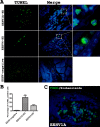Possible roles of monocytes/macrophages in response to elephant endotheliotropic herpesvirus (EEHV) infections in Asian elephants (Elephas maximus)
- PMID: 31491031
- PMCID: PMC6730851
- DOI: 10.1371/journal.pone.0222158
Possible roles of monocytes/macrophages in response to elephant endotheliotropic herpesvirus (EEHV) infections in Asian elephants (Elephas maximus)
Abstract
Elephant endotheliotropic herpesvirus-hemorrhagic disease (EEHV-HD) is the primary cause of acute, highly fatal, hemorrhagic diseases in young Asian elephants. Although monocytopenia is frequently observed in EEHV-HD cases, the role monocytes play in EEHV-disease pathogenesis is unknown. This study seeks to explain the responses of monocytes/macrophages in the pathogenesis of EEHV-HD. Samples of blood, frozen tissues, and formalin-fixed, paraffin-embedded (FFPE) tissues from EEHV1A-HD, EEHV4-HD, co-infected EEHV1A and 4-HD, and EEHV-negative calves were analyzed. Peripheral blood mononuclear cells (PBMCs) from the persistent EEHV4-infected and EEHV-negative calves were also studied. The results showed increased infiltration of Iba-1-positive macrophages in the inflamed tissues of the internal organs of elephant calves with EEHV-HD. In addition, cellular apoptosis also increased in the tissues of elephants with EEHV-HD, especially in the PBMCs, compared to the EEHV-negative control. In the PBMCs of persistent EEHV4-infected elephants, cytokine mRNA expression was high, particularly up-regulation of TNF-α and IFN-γ. Moreover, viral particles were observed in the cytoplasm of the persistent EEHV4-infected elephant monocytes. Our study demonstrated for the first time that apoptosis of the PBMCs increased in cases of EEHV-HD. Furthermore, this study showed that monocytes may serve as a vehicle for viral dissemination during EEHV infection in Asian elephants.
Conflict of interest statement
The authors have declared that no competing interests exist.
Figures






Similar articles
-
In vivo characterization of target cells for acute elephant endotheliotropic herpesvirus (EEHV) infection in Asian elephants (Elephas maximus).Sci Rep. 2020 Jul 9;10(1):11402. doi: 10.1038/s41598-020-68413-4. Sci Rep. 2020. PMID: 32647124 Free PMC article.
-
Lethal Hemorrhagic Disease and Clinical Illness Associated with Elephant Endotheliotropic Herpesvirus 1 Are Caused by Primary Infection: Implications for the Detection of Diagnostic Proteins.J Virol. 2020 Jan 17;94(3):e01528-19. doi: 10.1128/JVI.01528-19. Print 2020 Jan 17. J Virol. 2020. PMID: 31723022 Free PMC article.
-
Pathogenesis of hemorrhagic disease caused by elephant endotheliotropic herpesvirus (EEHV) in Asian elephants (Elephas maximus).Sci Rep. 2021 Jun 21;11(1):12998. doi: 10.1038/s41598-021-92393-8. Sci Rep. 2021. PMID: 34155304 Free PMC article.
-
Production of antibody against elephant endotheliotropic herpesvirus (EEHV) unveils tissue tropisms and routes of viral transmission in EEHV-infected Asian elephants.Sci Rep. 2018 Mar 16;8(1):4675. doi: 10.1038/s41598-018-22968-5. Sci Rep. 2018. PMID: 29549315 Free PMC article.
-
Review of Elephant Endotheliotropic Herpesviruses and Acute Hemorrhagic Disease.ILAR J. 2016;56(3):283-96. doi: 10.1093/ilar/ilv041. ILAR J. 2016. PMID: 26912715 Free PMC article. Review.
Cited by
-
In vivo characterization of target cells for acute elephant endotheliotropic herpesvirus (EEHV) infection in Asian elephants (Elephas maximus).Sci Rep. 2020 Jul 9;10(1):11402. doi: 10.1038/s41598-020-68413-4. Sci Rep. 2020. PMID: 32647124 Free PMC article.
-
Phagocytic Function and Flow Cytometric Phenotype of Asian Elephant Monocytes.Animals (Basel). 2024 Aug 7;14(16):2297. doi: 10.3390/ani14162297. Animals (Basel). 2024. PMID: 39199831 Free PMC article.
-
Tissue and cellular tropism of elephant endotheliotropic herpesvirus (EEHV)1A in hemorrhagic disease.PLoS One. 2025 Sep 2;20(9):e0330631. doi: 10.1371/journal.pone.0330631. eCollection 2025. PLoS One. 2025. PMID: 40892760 Free PMC article.
-
Direct detection of elephant endotheliotropic herpesvirus 1 (EEHV1) DNA in heparinized plasma by loop-mediated isothermal amplification.J Vet Med Sci. 2023 Mar 30;85(4):459-462. doi: 10.1292/jvms.22-0578. Epub 2023 Mar 15. J Vet Med Sci. 2023. PMID: 36792210 Free PMC article.
-
Clinical characteristics of elephant endotheliotropic herpesvirus (EEHV) cases in Asian elephants (Elephas maximus) in Thailand during 2006-2019.Vet Q. 2021 Dec;41(1):268-279. doi: 10.1080/01652176.2021.1980633. Vet Q. 2021. PMID: 34511026 Free PMC article.
References
-
- Wilkie GS, Davison AJ, Kerr K, Stidworthy MF, Redrobe S, Steinbach F, et al. First fatality associated with elephant endotheliotropic herpesvirus 5 in an Asian elephant: pathological findings and complete viral genome sequence. Scientific Reports. 2014. September 09;4:6299 10.1038/srep06299 - DOI - PMC - PubMed
-
- Richman LK, Zong JC, Latimer EM, Lock J, Fleischer RC, Heaggans SY, et al. Elephant endotheliotropic herpesviruses EEHV1A, EEHV1B, and EEHV2 from cases of hemorrhagic disease are highly diverged from other mammalian herpesviruses and may form a new subfamily. Journal of Virology. 2014. December;88(23):13523–46. 10.1128/JVI.01673-14 - DOI - PMC - PubMed
-
- Dastjerdi A, Seilern-Moy K, Darpel K, Steinbach F, Molenaar F. Surviving and fatal Elephant Endotheliotropic Herpesvirus-1A infections in juvenile Asian elephants—lessons learned and recommendations on anti-herpesviral therapy. BMC Veterinary Research. 2016. August 27;12(1):178 10.1186/s12917-016-0806-5 - DOI - PMC - PubMed
Publication types
MeSH terms
Substances
LinkOut - more resources
Full Text Sources

